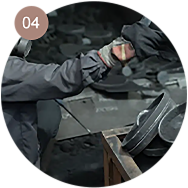
Essential Guide to Cooking with Cast Iron Skillets and Pots for Delicious Meals
The Versatility and Benefits of Cast Iron Skillets and Pots
When it comes to kitchen cookware, few items are as beloved and versatile as cast iron skillets and pots. Renowned for their robust construction and excellent heat retention properties, these kitchen staples have been used for generations, finding their way into homes across the world. In this article, we will explore the benefits of cast iron cookware, its various uses, and the care tips necessary to maintain its durability.
Benefits of Cast Iron Cookware
One of the most significant advantages of cast iron skillets and pots is their exceptional heat retention and distribution. Unlike cheaper alternatives which may warp or distribute heat unevenly, cast iron maintains a consistent temperature throughout cooking. This property makes them ideal for a range of cooking methods—from frying and sautéing to baking and roasting. Whether you're searing meats or baking cornbread, the consistent heat provides impressive results, making them a favorite among professional chefs and home cooks alike.
Moreover, cast iron cookware is incredibly durable. With proper care, a cast iron skillet or pot can last for years, even generations. These pieces often improve with age; as they are used and seasoned, they develop a natural, non-stick surface that can enhance flavors in your food. The seasoning process creates a unique patina that can add depth and richness to dishes, resulting in a truly unique culinary experience.
Another notable benefit is the health aspect. Cast iron cookware can add small amounts of iron to your food, an essential mineral that is crucial for many bodily functions. This can be particularly beneficial for individuals who may be deficient in iron. Cooking with cast iron also avoids many of the chemicals present in non-stick coatings, making it a safer choice for health-conscious consumers.
Versatility in Cooking
cast iron skillet pot

Cast iron skillets and pots are remarkably versatile, functioning well on various heat sources, including stovetops, ovens, and even outdoor grills or campfires. This adaptability allows for a broader spectrum of recipes to be prepared. From stovetop sautéing to oven-baked casseroles, from frying fish to slow-cooking stews, the possibilities are endless.
One of the standout features of cast iron cookware is its ability to create a perfect crust on meats. The intense heat retention allows for an exceptional sear, locking in flavor and moisture. Additionally, the even heat distribution ensures that meats cook uniformly, further enhancing the dish's overall quality.
Furthermore, the aesthetic appeal of cast iron cookware cannot be overlooked. Many cast iron skillets and pots are designed to be visually appealing, making them suitable for serving straight from the stove to the dining table. Their rustic charm can add a touch of warmth and authenticity to any meal.
Care and Maintenance
To ensure the longevity of your cast iron skillet or pot, proper care is essential. After each use, it is recommended to clean your cast iron cookware with hot water and a stiff brush. Avoid using soap and never place it in the dishwasher, as this can strip away the seasoning. After washing, dry it immediately to prevent rust. It's best to reapply a light coat of cooking oil to maintain the seasoning and prevent sticking.
Over time, if your cast iron develops rust or the seasoning appears compromised, it can be restored. With a bit of patience and effort, you can strip the old seasoning and re-season the cookware, bringing it back to life for many more years of perfect cooking.
In conclusion, cast iron skillets and pots are invaluable tools in the kitchen, thanks to their durability, versatility, and health benefits. With proper care, these timeless pieces of cookware can become cherished family heirlooms that will serve not just as cooking vessels but as a bridge connecting generations through shared meals and culinary traditions. So, whether you're a novice cook or an experienced chef, investing in cast iron cookware is undoubtedly a smart choice for the modern kitchen.
-
Season Cast Iron Perfectly with GPT-4 Turbo TipsNewsAug.01,2025
-
High Quality Cast Iron Cookware - Baixiang County Zhongda MachineryNewsAug.01,2025
-
Premium Cast Iron Pan: Durable & Perfect HeatNewsAug.01,2025
-
High Quality Kitchen Durable Black Round Cast Iron Cookware Pancake Crepe Pan-Baixiang County Zhongda Machinery Manufacturing Co., Ltd.NewsAug.01,2025
-
Cast Iron Cookware - Baixiang County Zhongda Machinery | Nonstick, Heat ResistanceNewsAug.01,2025
-
High Quality Kitchen Durable Black Round Cast Iron Cookware - Baixiang County Zhongda Machinery | Non-Stick, Heat Retention, DurableNewsJul.31,2025


